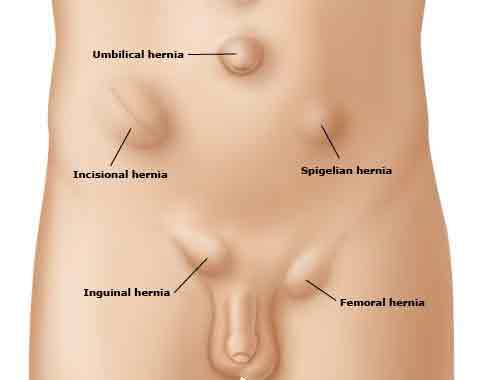A hernia occurs when a part of an internal organ bulges through a weak area of the muscle that holds it in place.
It usually happens in the abdomen, but can also appear in other parts of the body.
Although, most hernias may not be life threatening, they hardly go away just like that.
Types Of Hernia
According to a 2008 study, abdominal wall hernias are common, with a prevalence of 1.7% for all ages and 4% for those aged over 45 years.
There are several types of hernias, but the most common kinds are inguinal (groin) and umbilical hernias.
“Inguinal hernias are more commonly found in men and often begin developing shortly before or after birth.
“Umbilical hernias form directly underneath the navel.”
Also, hernias that occur at the site of previous surgery are also quite common.
Inguinal Hernias
They occur near the crease, between the lower abdomen and the upper thigh.
“When an inguinal hernia develops, intestine may protrude through the defect in the abdominal wall. This creates a bulge on the right or left side. Inguinal hernia bulges are frequently, though not always, painful.”
Sadly, between 10 and 15 per cent of males and 2 per cent of females will develop inguinal hernias in their lifetime.
Ventral Hernias
They are less common than inguinal hernias. About 10% of both males and females could develop one during their lifetime.
These hernias occur outside the inguinal area of the abdomen, in the epigastrium, the part of the abdominal wall above the umbilicus (belly button) and/or within the umbilicus itself.
Incisional Hernias
This kind of hernia occurs as a result of previous surgery in the abdomen that may have weakened the abdominal wall.
It may also happen where infection in a healing surgical incision causes breakdown of the wound closure.
Incisional hernias are common in patients who have had intestinal surgery complicated by wound infections.
About 25 to 30 per cent of both males and females will develop an incisional hernia when a wound infection occurs after abdominal surgery.
Hiatial Hernias
This takes place in the diaphragm, the large muscle separating the chest cavity and the abdomen.
Basically, the diaphragm is responsible for much of our breathing. This could be repaired by surgeons.
Symptoms Of Hernia
According to experts, inguinal hernias present with a lump in the area where your groin and thigh meet. This lump goes away with minimal pressure.
An individual with hernia also feels relieved when lying down.
Sadly, most hernias cause mild to moderate discomfort that increases with activity.

Unfortunately, hernia may also present no pains.
According to the 2008 study, 1/3 of patients scheduled for surgery have no pain. Severe pain is also uncommon (1.5% at rest and 10.2% on movement).
Have You Read: Loss Of Sense Of Smell: Causes, Issues Plus What To Do
Once you notice any of these signs and you suspect that you have hernia, see your doctor,
Experts warn that an untreated hernia won’t go away by itself.
Once your doctor assesses the condition, the doctor will determine how it could be treated.
Basically, hernias can cause life-threatening complications and this is why you should seek medical care.
Diagnosis
Experts at the Columbia University say a hernia is usually fairly straightforward to diagnose, as a patient will often feel a bulge.
This bulge is often accompanied by localised pain or discomfort, and may even feel something pushing through the hernia.
“Less commonly, one will only feel general pain or discomfort in the area without being able to localize its origin.”
Causes Of Hernia
Basically, inguinal and ventral hernias may develop due to a number of factors.
They include obesity, aging, and strenuous physical activity requiring heavy lifting, such as construction work.
Unfortunately, some rare conditions such as collagen vascular disease or genetic defects involving connective tissue may also cause abdominal hernias.
Hernia could arise as a result of a congenital condition that may have happened during development in the womb and is present from birth.

Others are aging, damage from an injury or surgery, chronic coughing or chronic obstructive pulmonary disorder (COPD).
Pregnancy, especially having multiple pregnancies, constipation, which causes you to strain when having a bowel movement and fluid in the abdomen, or ascites could also cause hernia.
Treatments
Hernia treatments are mainly surgical repairs often conducted using one of two surgical approaches.
People Loved To Read: Colon Cancer: 7 Things You Should Know
Both of these approaches use a piece of synthetic, or prosthetic, mesh to reinforce the weakness in the abdominal wall.
When performed well, these approaches result in a successful hernia repair.
Open Surgical Repair
Here, the surgeon makes an incision directly over the hernia defect.
Afterwards, the doctor sews the prosthetic mesh to the abdominal wall.
Laparoscopic Surgery
This is an alternative repair that is done using a minimally invasive, or laparoscopic, approach.
It is performed while the patient is under general anesthesia.
Remedies
Some of the remedies that could bring relief are early medical care and lifestyle changes.
Food choices could help and some of the foods recommended are those high in fibre content.
Whole grains, fruits, leafy greens and other high fibre foods fall into this category.
Indeed, they help relieve constipation which could cause straining during bowel movements.
It lowers chances of this constipation aggravating a hernia. But the only effective way to treat a hernia is through surgical repair.
Kindly share with your friends and loved ones to enable know all they could about hernia.



